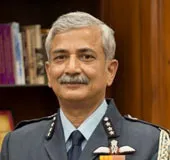.png)
Two and a half decades have passed since the Indian military fought in stark desolate icy heights of the Kargil to repel the intruders sent covertly by the Pakistani Army to sever the strategic NH-1 highway lifeline to Leh and further onto the Siachen Glacier. General Pervez Musharraf, the mastermind of Operation Koh-e-Paima (KP), hoped to alter India’s dominant position in the glacier by strangling the supply route, opening another infiltration route for militants, and changing the alignment of the Line of Control (LoC). The valiant and victorious fightback of the Indian Army was equally shouldered by the Indian Air Force, in what was the highest employment of offensive air power ever in the world.
After the initial surprise and the fog of confusion, given the covert infiltration that took advantage of the winter surveillance gap, the extent and gravity of the intrusion unfolded slowly to reveal the active hand of the Pakistan Army. What followed was a strategic and measured government response, which not only cleared the military action to evict the intruders but also the use of kinetic air power, albeit with a caveat—no crossing of the LoC. Once the initial misunderstanding of the Army concerning the need for political clearance for offensive use of air power in peacetime was resolved, the two Services got down to the business of fighting India’s first ‘televised war’.
Even before the government cleared the IAF into action on 25 May 1999, the Air Chief gave directions for the activation of contingency plans. Air defence fighters and radars in the Srinagar Valley were put on a 24-hour vigil, and designated fighter units were tasked with conducting air-to-ground live firing drills at the high-altitude firing range, as well as area familiarisation sorties. Over the next few days, in addition to the logistical support to the Army for airlifting troops and supplies, the Air Force carried out photo and electronic reconnaissance missions to establish enemy deployment. At first light on 26 May, air strikes by MiG 21, 23, and 27 fighters commenced against intruder camps, materiel dumps, and supply routes in the general areas overlooking Dras, Kargil, and Batalik. The white sea of snow of the Himalayan mountain terrain which inspired the code name of Operation Safed Sagar also exemplified the extreme challenges of high-altitude targeting where the steep narrow valleys restricted the fighter manoeuvrability and severely limited the attack directions. To complicate matters the rarified atmosphere affected the aircraft and weapon performance, and the high speed and altitude combination made target acquisition extremely difficult. From the fighter cockpit, a large bunker, or a gun position appeared as specks of a few millimetres in size, almost invisible to spot in the black-and-white contrast of the rocky snowbound mountainsides at ground speeds of over 700 kmph.
Even before the government cleared the IAF into action on 25 May 1999, the Air Chief gave directions for the activation of contingency plans. Air defence fighters and radars in the Srinagar Valley were put on a 24-hour vigil, and designated fighter units were tasked with conducting air-to-ground live firing drills at the high-altitude firing range, as well as area familiarisation sorties.
The loss of a fighter and a helicopter to shoulder-fired Stinger surface-air missiles (SAM) and a fighter to engine surge during its attack in the early days, forced a tactics reset. The shift of tactics to higher weapon-release altitudes to stay clear of the SAM lethal envelope brought in added challenges of reduced weapon accuracy. These were offset by changes in attack profiles steep dive attacks, the novel use of GPS-aided level bombing by day and night, better target-to-weapon matching, the first use of laser targeting pods, and precision-guided weapons. The continuous bombing by these older platforms, despite their reduced accuracy compared to precision weapons, had a tremendously demoralising effect on the enemy and was a morale booster for the Army which was fighting herculean battles in unbelievably adverse conditions. Newly obtained Litening targeting pods were speedily integrated and the M 2000 was modified externally for carriage of the Paveway II laser-guided bomb and its weapon system was tweaked for delivery of the weapons it was not designed for. This helped in the destruction of the command post on Tiger Hill which was being used to direct artillery fire on Indian positions, the largest logistics camp at Muntho Dhalo, and other key targets. The sustained and accurate air strikes also surprised Pakistani planners who had not factored in the determined Indian response and use of air power.
The loss of a fighter and a helicopter to shoulder-fired Stinger surface-air missiles (SAM) and a fighter to engine surge during its attack in the early days, forced a tactics reset.
As PAF F-16s flew Combat Air Patrols across the border and deployed a flight of F-7P fighters at Skardu airfield north of Srinagar, IAF’s strikes needed full freedom of operation while operating close to the LOC. This meant that extensive Air Defence (AD) cover had to be provided, not only to ensure freedom of own air operations but also to deny the PAF any opportunity to interfere with the Indian Army operations using stand-off weapon delivery. An important aspect that kept the PAF at bay was the advantage of a better beyond-visual range air-air missile capability of the IAF MiG 29s. The full-scale IAF activation and deployment of the newly inducted BVR armed Su 30K fighters on CAP missions in the Gujarat sector tied down the PAF forcing it to stay out of the conflict. From a joint perspective, the most vital preponderant was the absence of enemy air and the consequent total freedom of surface and air operations that was made possible due to the control of the air, an outcome of IAF’s aggressive AD missions. Two decades later, the temporary reversal of this critical BVR advantage due to the PAF having been supplied with the Advance Medium Range Air to Air Missile by the US, altered the equation in favour of Pakistan in the post-Balakot strike activation, forcing the IAF on the defensive.
An important aspect that kept the PAF at bay was the advantage of a better beyond-visual range air-air missile capability of the IAF MiG 29s.
The successful outcome of the incessant air interdiction strikes in severing the enemy logistic arteries and degrading its ability to sustain itself across the wide frontage was borne out by enemy radio intercepts. Timely aerial reconnaissance that detected the enemy's plans to shift to alternate supply routes enabled accurate follow-on precision strikes. Nasim Zehra, a national security specialist, noted that “the raining bombs and shells, psychologically hit the soldiers perched on the mountain tops,” underscoring the efficacy of IAF’s air strikes. She also highlights that “as Indian air power bombed out the supply routes, there were no alternate routes available” and the Pakistani “troops had been left exposed, vulnerable and unfed.” The planning for Operation KP was it appears fatally flawed as “The Pakistani planners had failed to assess the involvement of air power, the capability of the IAF and the Indian Army’s determination.”
The invaluable air mobility, logistics, and maintenance support provided by the thousands of hours of flying in extremely challenging conditions of terrain, adverse weather, and pushing aircrew fatigue and aircraft operational limits, cannot be missed in the credits. The unsung round-the-clock operations of the helicopter and transport fleets, which were vital in air logistics of troops, weapons, artillery guns, and supplies, and the extensive casualty evacuations, played an equal part in the conduct and successful outcome of the conflict. As the two Services came together, joint planning and execution once again proved a critical war-fighting necessity and the most enduring takeaway. Two decades later during the Galwan crisis in Ladakh in 2020, the IAF implemented every AD, offensive air power, and combat support lesson of Kargil, in its swift and extensive activation ‘geared to undertake all operational tasks and providing support to all military operations’, in close coordination with the Army.. The shadows of Kargil, thus, remain future-relevant in India’s national security in the years ahead.
Air Marshal Diptendu Choudhury is a former Commandant of the National Defence College at New Delhi.
The views expressed above belong to the author(s). ORF research and analyses now available on Telegram! Click here to access our curated content — blogs, longforms and interviews.



.png)
 PREV
PREV


.png)